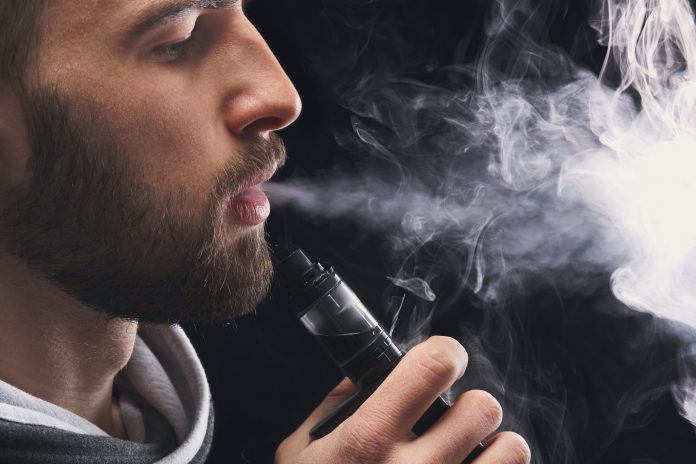The use of electronic cigarettes (e-cigarettes) has exploded over recent years. In contrast to conventional cigarettes in which tobacco leaves are combusted to deliver nicotine via smoke, e-cigarettes are battery-powered devices that deliver nicotine by heating a liquid solution to form an aerosol
Globally, e-cigarette use is increasing most rapidly amongst young people, age 17 and under; in the United States, e-cigarettes have largely replaced conventional cigarettes in high schools. Despite their popularity, little is known about the health effects associated with e-cigarette use.
Many users believe e-cigarettes cause fewer adverse health effects than combustible tobacco cigarettes. Proponents also tout e-cigarettes as devices that help tobacco smokers to quit conventional cigarette use. Opponents are concerned about health risks associated with exposure to toxic substances in e-cigarette emissions and abuse liability, especially amongst first-time tobacco product users, such as youth and young adults.
Currently, there is little scientific evidence to determine which side is right because e-cigarette use is a relatively recent phenomenon. Thus, we are witness to a public health experiment on a global scale.
To address rising concerns regarding the safety of e-cigs, the U.S. National Academies of Sciences, Engineering, and Medicine convened an expert committee to conduct a critical, objective review of the available peer-reviewed science.
The committee, whose findings were recently published1, concluded that across a range of studies and outcomes, e-cigarettes appear to pose fewer health risks than combustible tobacco cigarettes. The committee also concluded, however, that e-cigarettes do have biological effects in humans, and the available evidence suggests that their long-term use likely increases risk of disease. The key findings of the committee were:
Exposure to nicotine and toxic substances: Nicotine exposure from e-cigarette aerosol is extremely variable depending on device characteristics and use, but nicotine exposures can be comparable to that from conventional cigarettes. Most e-cigarettes contain and emit numerous potentially toxic substances although, under typical conditions of use, exposure to toxic substances is lower with e-cigs compared to conventional cigarettes. E-cigarette use increases airborne concentrations of particulate matter and nicotine in indoor environments compared with background levels, although second-hand exposure is likely lower from e-cigarettes compared with conventional cigarettes.
Dependence and abuse liability: E-cig use results in symptoms of dependence, although, depending upon the types of e-liquids and devices used, the risk and severity of dependence is likely lower for e-cigarettes than for conventional cigarette. E-cigarette use by youth and young adults increases the likelihood they will use conventional cigarettes.
Harm reduction: Completely substituting e-cigarettes for conventional cigarettes reduces users’ exposure to many toxicants and carcinogens present in conventional cigarettes, and reduces short-term adverse health outcomes in several organ systems.
Adverse health effects of e-cigarette use: While there is as yet no data regarding the potential for e-cigarette use to promote cancer, limited evidence from animal studies supports the hypothesis that long-term e-cigarette use increases cancer risk. There is no available evidence regarding the influence of e-cigarettes on respiratory disease in adults, but there is moderate evidence that e-cigarette use increases coughing and exacerbates asthma in adolescents. The influence of e-cigarette use on pregnancy outcomes and development of the fetus is unknown.
Injuries and poisonings: E-cigs can explode and cause burns and projectile injuries as a result of poor-quality batteries or improper use and storage of devices. Intentional or accidental exposures to e-liquids (eye contact, skin contact or drinking) can cause seizures, anoxic brain injury, and other poisoning symptoms. Intentionally or accidentally drinking or injecting e-liquids can be fatal.
Overall, there is an urgent need for more research regarding the short-term and long-term health effects of e-cigarettes. Maximising the potential health benefits associated with e-cigarettes will require determining whether and under what conditions e-cigarettes help people quit smoking, discouraging use by youth through education and access restriction, regulating labelling of e-liquid contents, and increasing device safety.
1National Academies of Sciences, Engineering, and Medicine. 2018. Public Health Consequences of E-Cigarettes. Washington, DC: The National Academies Press. https://doi.org/10.17226/24952.
Pamela J. Lein
Professor of Neurotoxicology
University of California, Davis/School of Veterinary Medicine
Tel: +1 530 752 1970
pjlein@ucdavis.edu
http://www.vetmed.ucdavis.edu/faculty/results.cfm?fid=19369
http://www.vetmed.ucdavis.edu/lein-lab/index.cfm








